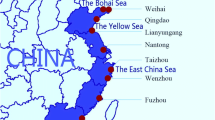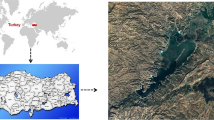Abstract
The unique climatic condition of the Dead Sea area makes it a renowned site for climatotherapy worldwide. Its water and mud are used for therapy and as sources for many cosmetic products. The high evaporation rate of the water of the Dead Sea makes the measurements of its minerals’ concentrations with time a necessity. Therefore, the aim of this study is to determine the metal contents in both water and mud of the Dead Sea which may have influence on human health. Major, minor and trace elements (Na, Mg, Ca, K, Fe, Al, Si, P, Ti, V, Cr, Mn, Co, Cu, Zn, Cd, Sb, Pb, Ni) concentrations were assessed in nine samples each of water, mud and sediments collected from the east shore of the Dead Sea. The analysis has been conducted using inductively coupled plasma optical emission spectrometry following combinations of acid digestion. The most abundant cation in the water is magnesium (40.0 g/L), while in the mud and sediment samples is calcium (39.9 g/kg and 3.82 g/kg). Heavy metal contents in these samples are lower than those observed for other water bodies, while those of Na, K, Mg and Ca are much higher than their counterparts of other water. The results showed an increase in the metal concentrations with time. The current study reveals that the mud of the Dead Sea can be used for cosmetic industry and it is safe to use the water for therapy.


Similar content being viewed by others
References
Al-Absi, A., Manasraha, R., Abukashabehb, A., & Wahshac, M. (2019). Assessment of heavy metal pollutants at various sites along the Jordanian coastline of the Gulf of Aqaba, Red Sea. International Journal of Environmental Analytical Chemistry,99, 726–740.
Abdel-Fattah, A. N. (1997). Mineralogical, geochemical, healing characterization and origin of the Dead Sea clay deposits. M.Sc. Thesis, University of Jordan, Amman, Jordan.
Abdel-Fattah, A. N., & Pingitore, N. E. (2009). Low level of toxic elements in Dead Sea black mud and mud-derived cosmetic products. Environmental Geochemistry and Health,31, 487–492.
Al Bawab, A., Bozeya, A., Abu-Mallouh, S., Abu Irmaileh, B., Daqour, I., & Abu-Zurayk, R. A. (2017). The Dead Sea mud and salt: A review of its characterization, contaminants, and beneficial effects. IOP Conference Series: Material Science and Engineering,305, 012003.
Al-Khashman, O. A. (2012). Assessment of heavy metal accumulation in urban soil around Potash industrial site in the east of the Dead Sea and their environmental risks. Soil and Sediment Contamination, An International Journal,21, 276–290.
Al-Khashman, O. A., & Shawabkeh, R. (2006). Metal distribution in soils around the cement factory in southern Jordan. Environmental Pollution,140, 387–394.
Alloway, B. J. (1989). Heavy metals in soils. Glasgow, London: Blackie and Sons.
Al-Nawayseh, K. (2003). Evaluation of surface and groundwater sources in Southern Ghore-Jordan. Ph.D. Thesis, Ain Shams University, Cairo, Egypt.
Bentor, Y. K. (1961). Some geochemical aspects of the Dead Sea and the question of its age. Geochimica et Cosmochimica Acta,25, 239–260.
Berg, T., Royset, O., Steinnes, E., & Vadset, M. (1995). Atmospheric trace element deposition: Principle component analysis of ICP-MS data from moss samples. Environmental Pollution, 88, 67–77.
Biasioli, R., Barberis, R., & Marson, F. A. (2006). The influence of a large city on some soil properties and metal content. Science of the Total Environment,356, 154–164.
Carreras, H. A., & Pignata, M. L. (2002). Biomonitoring of heavy metals and air quality in Cordoba city, Argentina, using transplanted lichens. Environmental Pollution,17, 77–87.
Ellis, J. B., & Revitt, D. M. (1982). Incidence of heavy metals in street surface sediments: Solubility and grain size studies. Water, Air and Soil Pollution,17, 87–100.
Es-Shahat, M. F., Al-Nawayseh, K. M., Jiries, A. G., & Al-Nasir, F. M. (2003). Pesticides and heavy metal distribution in southern Dead Sea basin. Bulletin of Environmental Contamination and Toxicology,71, 1230–1238.
Gharaibeh, M. A., Marschner, B., Heinze, S., & Moos, N. (2020). Spatial distribution of metals in soils under agriculture in the Jordan Valley. Geoderma Regional,20, e00245.
Gates, D. M. (1965). Radiant energy, its receipt and disposal. Meteorological Monographs,6, 28.
Gavrieli, I. (1997). Halite deposition from the Dead Sea: 1960–1993. In T. M. Niemi, Z. Ben-Avraham, & J. R. Gat (Eds.), The Dead Sea: The lake and its setting (pp. 161–170). Oxford: Oxford University Press.
Harat, M., Sela, Y., Ingber, A., & Vardy, D. (2016). Dead sea climatotherapy for psoriasis vulgaris: analysis of short-term results. Global Dermatology,3, 295–301.
Howari, F. M., Abu-Rukah, Y., & Goodell, P. C. (2004). Heavy metal pollution of soils along North Shuna—Aqaba Highway, Jordan. International Journal of Environment and Pollution,22, 597–607.
Katz, A., & Starinsky, A. (2009). Geochemical history of the Dead Sea. Aquatic Geochemistry,15, 159–194.
Khlaifat, A. (2008). Dead Sea rate of evaporation. American Journal of Applied Sciences,5, 934–942.
Khlaifat, A., Hohan, M., Phillips, G., Nawayseh, K., Amira, J., & Talafeha, E. (2010). Long term monitoring of Dead Sea level and brine physico-chemical parameter “from 1987–2008”. Journal of Marine Systems,81, 207–212.
Krumgalz, B. S., Hecht, A., Starinsky, A., & Katz, A. (2000). Thermodynamic constraints on Dead Sea evaporation: Can the Dead Sea dry up? Chemical Geology,165, 1–11.
Lensky, N. G., Dvorkin, Y., Lyakhovsky, V., Gertman, I., & Gavrieli, I. (2005). Water, salt and energy balances of the Dead Sea. Water Resources Research,41, W12418.
Mazor, E., Rosenthal, E., & Eckstein, J. (1969). Geochemical tracing of mineral water sources in the Southwestern Dead Sea basin. Journal of Hydrology,7, 246–265.
Momani, K., El-Hasan, T., Auaydeh, S., & Al-Nawayseh, K. (2009). Heavy metals distribution in the Dead Sea black mud, Jordan. Jordan Journal of Earth and Environmental Sciences,2, 50–59.
Neev, D., & Emery, K. O. (1967). The Dead Sea. Israel Geology Survey Bullion,41, 1–144.
Nissenbaum, A. (1977). Minor and trace elements in Dead Sea water. Chemical Geology,19, 99–111.
Omaish, Y. O. (1996). Climatotherapy at the Dead Sea in Jordan. Clinics in Dermatology,14, 659–664.
Oren, A., Gurevich, P., Anati, D. A., Barkan, E., & Luz, B. (1995). Dynamics of a bloom of halophilic archaea in the Dead Sea. Hydrobiologia,297, 173–185.
Ouillon, R., Lensky, N. G., Lyakhovsky, V., Arnon, A., & Meiburg, E. (2019). Halite precipitation from double-diffusive salt fingers in the Dead Sea: Numerical simulations. Water Resources Research,55, 4252–4255.
Peters, R. W., Li, W., Miller, G. & Brewster, M. D. (1996). Batch chelant extraction of heavy metals from contaminated soils. In Proceedings of the Fourth Great Lakes, Geotechnical/Geoenvironmental Conference on In Situ Remediation of Contaminated Sites, Chicago
Pinho, S. P., & Macedo, E. A. (2005). Solubility of NaCl, NaBr, and KCl in water, methanol, ethanol, and their mixed solvents. Journal of Chemical Engineering Data,50, 129–132.
Rabadi, A. (2016). The Red Sea-Dead Sea desalination project at Aqaba. Desalination and Water Treatment,57, 22713–22717.
Schoenfeld, L., & Held, S. (1965). Spectrochemical methods for determining B, Ba, Li, and Rb in Mediterranean and Dead Sea water. IAEC Report IA-1061, 17 pp.
Stiller, M., & Sigg, L. (1990). Heavy metals in the Dead Sea and their coprecipitation with halite. Hydrobiologia, 197, 23–33.
White, J. H., Yaniv, A. E., & Schick, H. (1966). The corrosion of metals in the water of the Dead Sea. Corrosion Science,6, 447–460.
Acknowledgements
The Deanship of Scientific Research (Grant No. 112/2014), Jordan University of Science and Technology, is greatly thanked.
Author information
Authors and Affiliations
Corresponding author
Rights and permissions
About this article
Cite this article
El-khateeb, M. Determination of metals’ contents in the Dead Sea’s water, mud and sediments. Int J Energ Water Res 4, 205–212 (2020). https://doi.org/10.1007/s42108-020-00067-4
Received:
Accepted:
Published:
Issue Date:
DOI: https://doi.org/10.1007/s42108-020-00067-4




